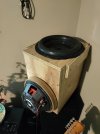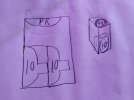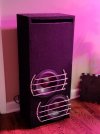CrankyElbow
Member
- Joined
- May 17, 2023
- Messages
- 6
- Likes
- 2
Over the years I've employed most all subwoofer designs - generally focusing on maximum output... most recently I've come to enjoy an isobaric configuration utilizing a passive radiator.
This offers the lowest extension for a given cabinet volume while also giving the opportunity for great tune-ability (assuming an easy way to vary PR mass).
The trade-off is an enclosure that is half the size required for 1 driver and a design that is as simple to construct as a sealed enclosure for 2 woofers (if the drivers are inverted and mounted together via a mounting ring)... for a bit of PR mud (as compared to a port, though this is mitigated by the isobarik arrangement and smaller enclosure) plus the cost of 2 subwoofer drivers that will only output as much as one. The output of a PR will not match that of a properly configured port (especially flared tubes)... said proper (low tuned with sufficient surface area) port in a small enclosure very well could DOUBLE the enclosure size.

Here I have 2 10" MB Quart shallow mount woofers, ds1-254 with an earthquake SLAPS-m12 12" PR. Enclosure is ~1.25 cubic feet. This PR is EXTREMELY capable and easily tuneable.. the drivers are nothing spectacular (from a car audio setup) - being shallow and relatively light weight simply makes them easier to work with. I have Dayton HO 10's RSS265HO-4 that work extremely well in the same configuration - but the drivers stick out much farther, throwing off the balance (the enclosure would tip over if it were placed the same way), and weigh much more... I'll likely go back to them and build a more presentable cabinet with better materials (that does not have an inverted woofer sticking out - a similar driver/PR layout but with one driver mounted internally and box dimensions mod'd to accommodate) once I get the overall setup more dialed in. Mounting the second woofer internally adds some complexity and added volume to the design that I was trying to avoid with this iteration... though I can likely drop to an internal volume of ~.75cu ft and maintain extension... which will end up with a similar external volume.

I've had extremely loud with no focus on sound quality and extremely high fidelity with barely enough output to satisfy, and everything in between over my ~30 years in audio... this configuration for a home theater/leisurely listening/fun to build and tune subwoofer is by far my favorite to date.
Here is a ported box that offers similar frequency response, and much more output with the same drivers utilized... note the tremendous size difference! MUCH heavier and so much more difficult to carry... personally I love this enclosure as a 'piece of furniture', but obviously its a bit much to "hide". This enclosure has its advantages, but the added output takes the configuration further into the "knock pictures off the walls" territory I have not been interested in for some years now... side note, I've tested this with 4 of the MB quart 10's in an isobaric configuration, which yielded a fantastic overall response.

This offers the lowest extension for a given cabinet volume while also giving the opportunity for great tune-ability (assuming an easy way to vary PR mass).
The trade-off is an enclosure that is half the size required for 1 driver and a design that is as simple to construct as a sealed enclosure for 2 woofers (if the drivers are inverted and mounted together via a mounting ring)... for a bit of PR mud (as compared to a port, though this is mitigated by the isobarik arrangement and smaller enclosure) plus the cost of 2 subwoofer drivers that will only output as much as one. The output of a PR will not match that of a properly configured port (especially flared tubes)... said proper (low tuned with sufficient surface area) port in a small enclosure very well could DOUBLE the enclosure size.

Here I have 2 10" MB Quart shallow mount woofers, ds1-254 with an earthquake SLAPS-m12 12" PR. Enclosure is ~1.25 cubic feet. This PR is EXTREMELY capable and easily tuneable.. the drivers are nothing spectacular (from a car audio setup) - being shallow and relatively light weight simply makes them easier to work with. I have Dayton HO 10's RSS265HO-4 that work extremely well in the same configuration - but the drivers stick out much farther, throwing off the balance (the enclosure would tip over if it were placed the same way), and weigh much more... I'll likely go back to them and build a more presentable cabinet with better materials (that does not have an inverted woofer sticking out - a similar driver/PR layout but with one driver mounted internally and box dimensions mod'd to accommodate) once I get the overall setup more dialed in. Mounting the second woofer internally adds some complexity and added volume to the design that I was trying to avoid with this iteration... though I can likely drop to an internal volume of ~.75cu ft and maintain extension... which will end up with a similar external volume.

I've had extremely loud with no focus on sound quality and extremely high fidelity with barely enough output to satisfy, and everything in between over my ~30 years in audio... this configuration for a home theater/leisurely listening/fun to build and tune subwoofer is by far my favorite to date.
Here is a ported box that offers similar frequency response, and much more output with the same drivers utilized... note the tremendous size difference! MUCH heavier and so much more difficult to carry... personally I love this enclosure as a 'piece of furniture', but obviously its a bit much to "hide". This enclosure has its advantages, but the added output takes the configuration further into the "knock pictures off the walls" territory I have not been interested in for some years now... side note, I've tested this with 4 of the MB quart 10's in an isobaric configuration, which yielded a fantastic overall response.

